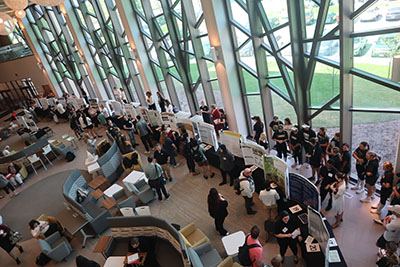Student Type
Undergraduate
Faculty Sponsor
Petey Mumford
Date
4-12-2022
College Affiliation
College of Science, Technology, and Health
Department
Kinesiology
Submission Type
Poster
Abstract
PURPOSE: To examine training modalities and muscle architecture characteristics between legs in collegiate cheer athletes. METHODS: Thirteen female collegiate cheer athletes (19 ± 1 years, 164.3 ± 6.8 cm, 63.0 ± 10.2 kg) were assessed for anthropometrics, a survey to assess type of training outside of cheer practice, and B mode ultrasound on both legs during a single visit. All ultrasound images were analyzed at 50% of the vastus lateralis for muscle thickness (MT), pennation angle (PA), and fascicle length (FL). RESULTS: Type of exercise training outside of practice counts: endurance (2), resistance (2), mixed (6), and do not train (3). We observed the following characters in the right leg (MT: 21.2 ± 2.2 mm, PA: 12.3 ± 2.7 deg, FL: 99.2 ± 27.0 mm) and left leg (MT: 21.1 ± 2.4 mm, PA: 13.2 ± 2.6 deg, FL: 86.2 ± 11.0 mm) with no differences observed between legs p>0.05. CONCLUSION: Given our sample size we observed more athletes performing a mix of endurance and resistance exercise, and no differences between legs for skeletal muscle characteristics.
Recommended Citation
Meyers, Amy; Duncan, Esther; Besancenez, Blair; Gruenke, Claire; and Mumford, Petey, "Assessment of Skeletal Muscle Characteristics in Female Collegiate Cheer Athletes" (2022). 2022 Student Academic Showcase. 12.
https://digitalcommons.lindenwood.edu/src/Posters/Session1/12
Publication Date
2022
Date
03/21/2022
Included in
Assessment of Skeletal Muscle Characteristics in Female Collegiate Cheer Athletes
PURPOSE: To examine training modalities and muscle architecture characteristics between legs in collegiate cheer athletes. METHODS: Thirteen female collegiate cheer athletes (19 ± 1 years, 164.3 ± 6.8 cm, 63.0 ± 10.2 kg) were assessed for anthropometrics, a survey to assess type of training outside of cheer practice, and B mode ultrasound on both legs during a single visit. All ultrasound images were analyzed at 50% of the vastus lateralis for muscle thickness (MT), pennation angle (PA), and fascicle length (FL). RESULTS: Type of exercise training outside of practice counts: endurance (2), resistance (2), mixed (6), and do not train (3). We observed the following characters in the right leg (MT: 21.2 ± 2.2 mm, PA: 12.3 ± 2.7 deg, FL: 99.2 ± 27.0 mm) and left leg (MT: 21.1 ± 2.4 mm, PA: 13.2 ± 2.6 deg, FL: 86.2 ± 11.0 mm) with no differences observed between legs p>0.05. CONCLUSION: Given our sample size we observed more athletes performing a mix of endurance and resistance exercise, and no differences between legs for skeletal muscle characteristics.


